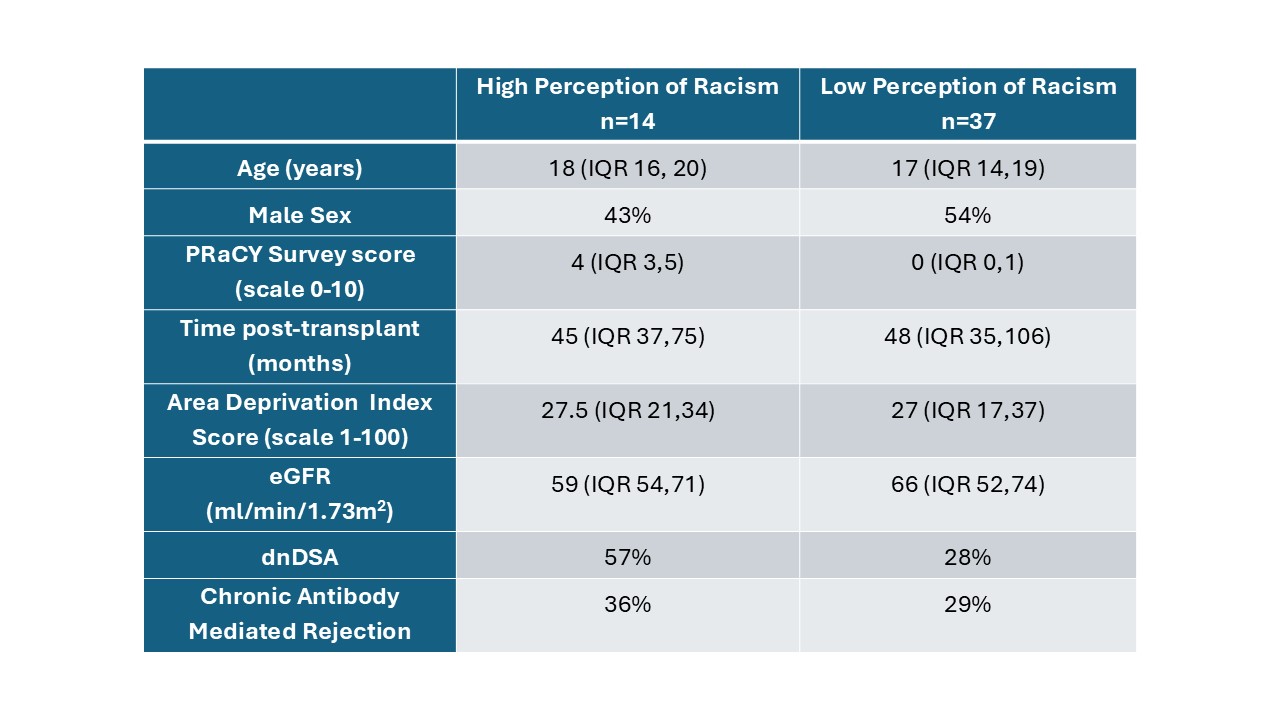Nephrology 1
Session: Nephrology 1
005 - Perceived Racism and Transplant Outcomes in Pediatric Kidney Transplant Recipients
Sunday, April 27, 2025
8:30am - 10:45am HST
Publication Number: 5.6172
Kristen Sgambat, Children's National Hospital, Silver Spring, MD, United States; Kaushal Amatya, George Washington University School of Medicine and Health Sciences, Washington, DC, United States; Asha Moudgil, Children's National Hospital, Silver Spring, MD, United States
- KS
Kristen Sgambat, PhD, R.D. (she/her/hers)
Clinical Assistant Professor
Children's National Hospital
Silver Spring, Maryland, United States
Presenting Author(s)
Background: Transplant outcomes have been shown to be worse among African American and Hispanic kidney transplant recipients compared to White (non-Hispanic) recipients. However, few studies have focused on the psychosocial drivers behind these adverse outcomes. Exposure to racism may manifest as medical mistrust and non-adherence, key risk factors for development of de novo donor specific antibodies (dnDSA), which can lead to chronic antibody mediated rejection (CABMR) over time. The relationship between perceived racism and transplant outcomes has not been previously described.
Objective: The objective of this cohort study was to investigate the association between perceived racism and transplant outcomes (dnDSA and CABMR) in a diverse population of pediatric kidney transplant recipients.
Design/Methods: Kidney transplant recipients 8 to 21 years old and >6 months post-transplant were eligible to enroll. Perceived racism was evaluated using the Perception of Racism in Children and Youth (PRaCY) questionnaire, scored from 0 to 10, with scores >/=3 indicating high perception of racism. Associations of perception of racism with transplant outcomes (dnDSA and CABMR) were evaluated by multivariate logistic regression, adjusted for time post-transplant, area deprivation index (ADI), age, and sex.
Results: The study population comprised 51 transplant recipients who were median 17 (IQR 14, 20) years old and 47 (IQR 36,105) months post-transplant with racial distribution 45% Hispanic, 27% African American, 12% White (non-Hispanic), 8% Asian, 8% Biracial. PRaCY survey scores of the entire cohort ranged from 0 to 9 (max possible=10). Descriptive characteristics of participants with high vs. low perception of racism are shown in Table 1. Prevalence of dnDSA in the high perception of racism group (57%) was more than double that of the low group (28%). CABMR was also more prevalent in those with high perception of racism vs. low (36% vs. 29%). Multivariate analysis showed that participants with high perception of racism had 4.6 higher odds of developing dnDSA after transplant, adjusted for time post-transplant, ADI, age, and sex, p=0.04 (Table 2). Association of perception of racism with CABMR did not reach statistical significance in multivariate analysis (p>0.05).
Conclusion(s): Pediatric transplant recipients with high perception of racism are more likely to develop dnDSA after transplant, which could portend higher risk of allograft loss in the future. Studies with larger sample size and longer follow up are needed to investigate how perceived racism impacts medication adherence, dnDSA formation, CABMR, and allograft loss.
Table 1. Descriptive characteristics of transplant recipients with high versus low perception of racism
 Continuous variables presented as median (IQR). Categorical variables presented as proportion (%). Abbreviations: Perception of Racism in Children and Youth (PRaCY), estimated glomerular filtration rate (eGFR), de novo Donor Specific Antibodies (dnDSA).
Continuous variables presented as median (IQR). Categorical variables presented as proportion (%). Abbreviations: Perception of Racism in Children and Youth (PRaCY), estimated glomerular filtration rate (eGFR), de novo Donor Specific Antibodies (dnDSA).Table 2. Association of high perception of racism with development of post-transplant dnDSA by multivariate regression
.jpg) *Transplant recipients with high perception of racism have 4.6 higher odds of developing de novo Donor Specific Antibodies (dnDSA) after transplant (p=0.04) by multivariate logistic regression, adjusted for time post-transplant, area deprivation index (ADI), age, and sex.
*Transplant recipients with high perception of racism have 4.6 higher odds of developing de novo Donor Specific Antibodies (dnDSA) after transplant (p=0.04) by multivariate logistic regression, adjusted for time post-transplant, area deprivation index (ADI), age, and sex. Table 1. Descriptive characteristics of transplant recipients with high versus low perception of racism
 Continuous variables presented as median (IQR). Categorical variables presented as proportion (%). Abbreviations: Perception of Racism in Children and Youth (PRaCY), estimated glomerular filtration rate (eGFR), de novo Donor Specific Antibodies (dnDSA).
Continuous variables presented as median (IQR). Categorical variables presented as proportion (%). Abbreviations: Perception of Racism in Children and Youth (PRaCY), estimated glomerular filtration rate (eGFR), de novo Donor Specific Antibodies (dnDSA).Table 2. Association of high perception of racism with development of post-transplant dnDSA by multivariate regression
.jpg) *Transplant recipients with high perception of racism have 4.6 higher odds of developing de novo Donor Specific Antibodies (dnDSA) after transplant (p=0.04) by multivariate logistic regression, adjusted for time post-transplant, area deprivation index (ADI), age, and sex.
*Transplant recipients with high perception of racism have 4.6 higher odds of developing de novo Donor Specific Antibodies (dnDSA) after transplant (p=0.04) by multivariate logistic regression, adjusted for time post-transplant, area deprivation index (ADI), age, and sex. 
